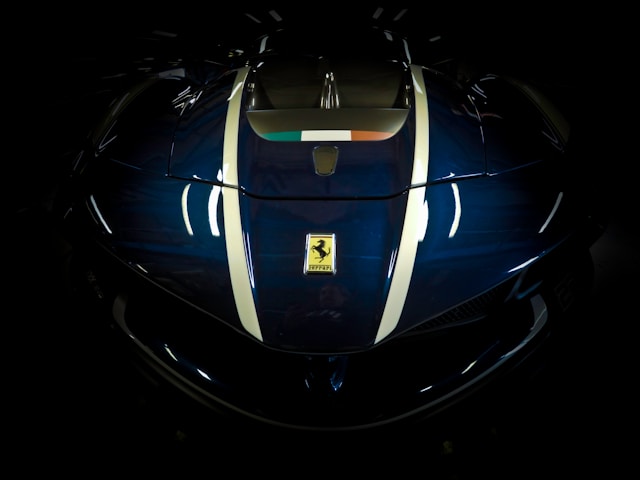When it comes to marketing a brand synonymous with luxury, speed, and exclusivity, few companies do it better than Ferrari. The iconic Italian car manufacturer has been a symbol of opulence and high performance since its inception in 1947. Ferrari’s marketing strategy is a masterclass in creating and maintaining a prestigious brand image while navigating the modern marketplace. This blog post explores the key components of Ferrari’s marketing approach, offering insights and inspiration for marketing professionals aiming to learn from one of the most successful brands in the world.
The Core of Ferrari’s Brand Identity
Ferrari’s brand identity is deeply rooted in its history, heritage, and racing pedigree. The company has always positioned itself as more than just a car manufacturer. It’s a creator of dreams and an emblem of success. Ferrari’s marketing strategy capitalizes on several core elements:
- Exclusivity and Scarcity
- Racing Heritage
- Customer Experience
- Brand Ambassadors and Partnerships
- Digital and Social Media Presence
Exclusivity and Scarcity
Ferrari has masterfully utilized the principles of exclusivity and scarcity to enhance its brand allure. By producing a limited number of vehicles each year, Ferrari creates a high demand that far exceeds supply. This strategy not only drives up the market value of their cars but also ensures that owning a Ferrari remains a prestigious status symbol.
Example: LaFerrari Launch
In 2013, Ferrari launched the LaFerrari, a hybrid hypercar with a production run of only 499 units. The limited availability of this model, combined with its cutting-edge technology and superior performance, created an immense buzz in the automotive world. Potential buyers had to be personally invited by Ferrari to purchase the car, adding another layer of exclusivity. This approach not only solidified Ferrari’s brand position but also ensured extensive media coverage and public interest.

Racing Heritage
Ferrari’s roots in motorsport are integral to its brand identity. Enzo Ferrari founded the company with a passion for racing, and this legacy continues to be a significant part of Ferrari’s marketing strategy. The brand leverages its successes in Formula 1 to enhance its image of high performance and engineering excellence.
Example: Scuderia Ferrari
Scuderia Ferrari, the racing team division, plays a crucial role in promoting the brand. Every victory on the track is a testament to Ferrari’s engineering prowess and innovation. The red cars, known as “Prancing Horses,” have become synonymous with speed and excellence. Ferrari’s participation in Formula 1 not only provides exposure but also aligns the brand with the elite, competitive spirit of the sport.
Customer Experience
Ferrari places a strong emphasis on delivering an exceptional customer experience. From personalized services to exclusive events, Ferrari ensures that its customers feel like part of an elite club. This personalized approach strengthens customer loyalty and reinforces the brand’s luxurious image.
Example: Ferrari Owners’ Clubs and Events
Ferrari organizes exclusive events such as the Ferrari Cavalcade, where owners from around the world gather to drive their cars through scenic routes, participate in track days, and enjoy social events. These experiences are designed to create a sense of community among Ferrari owners while reinforcing the brand’s image of luxury and exclusivity.
Brand Ambassadors and Partnerships
Ferrari leverages strategic partnerships and brand ambassadors to amplify its reach and appeal. Collaborations with high-profile personalities and brands help Ferrari tap into new audiences and maintain its prestigious image.
Example: Ferrari and Hublot
In 2011, Ferrari partnered with Swiss luxury watchmaker Hublot to create a line of exclusive timepieces. This partnership combined the heritage and craftsmanship of both brands, resulting in products that appealed to affluent customers who appreciate luxury and precision. Such collaborations not only expand Ferrari’s brand presence but also reinforce its association with other high-end, prestigious brands.

Digital and Social Media Presence
While Ferrari’s marketing strategy is deeply rooted in tradition and heritage, the brand also embraces modern marketing channels to engage with a broader audience. Ferrari’s digital and social media presence is meticulously curated to reflect its brand values and appeal to its passionate fanbase.
Example: Ferrari’s Social Media Campaigns
Ferrari has a strong presence on platforms like Instagram, Twitter, and YouTube, where it shares stunning visuals of its cars, behind-the-scenes content, and updates from the racing world. The brand’s use of high-quality imagery and video content helps to maintain its luxurious image online. Additionally, Ferrari engages with its community through interactive campaigns and exclusive online content, fostering a sense of connection with fans and customers alike.
Crafting the Ferrari Experience: A Detailed Look at Campaigns
To truly understand Ferrari’s marketing strategy, it’s essential to delve into specific campaigns that have exemplified the brand’s approach to marketing.
The Ferrari 488 Pista Launch
In 2018, Ferrari unveiled the 488 Pista, a track-focused version of the 488 GTB. The marketing campaign for this model was a textbook example of creating anticipation and excitement around a new release.
Teaser Campaigns and Limited Previews
Ferrari began with a series of teaser videos and images on social media, highlighting the car’s design and performance features without revealing the entire vehicle. This approach built suspense and encouraged speculation among fans and automotive journalists.
Exclusive Events
Ferrari hosted a series of private preview events for select customers and media representatives. These events allowed attendees to experience the car firsthand and provided a platform for Ferrari to showcase the vehicle’s capabilities in a controlled, immersive environment.
Leveraging Influencers and Media
By inviting prominent automotive influencers and journalists to these events, Ferrari ensured extensive coverage and reviews from trusted voices in the industry. This strategy amplified the car’s exposure and generated buzz across various media channels.
Highlighting Racing Pedigree
Throughout the campaign, Ferrari emphasized the 488 Pista’s connection to the brand’s racing heritage. Marketing materials highlighted the car’s advanced aerodynamics, powerful engine, and lightweight construction, all of which were derived from Ferrari’s Formula 1 technology.
The Icona Series: Monza SP1 and SP2
In 2018, Ferrari introduced the Icona series with the Monza SP1 and SP2, limited-edition models inspired by the brand’s classic race cars. This campaign was a masterclass in blending heritage with modern innovation.
Storytelling and Heritage
Ferrari crafted a compelling narrative around the Monza SP1 and SP2, drawing parallels between the new models and the legendary Ferrari race cars of the 1950s. This storytelling approach resonated with enthusiasts who appreciate the brand’s history and legacy.
Exclusive Unveiling
The cars were unveiled at a private event during the Capital Markets Day at Ferrari’s headquarters in Maranello, Italy. This exclusive setting underscored the models’ limited availability and reinforced the brand’s image of luxury and exclusivity.
Limited Availability
Ferrari announced that only 499 units of the Monza SP1 and SP2 would be produced, and potential buyers would be handpicked by the company. This approach not only ensured that the cars remained exclusive but also generated significant interest and media coverage.
Integrated Marketing Approach
The campaign included a mix of traditional and digital marketing channels. High-quality print ads in luxury lifestyle magazines complemented digital content on social media and the Ferrari website. This integrated approach ensured that the campaign reached a diverse audience while maintaining a consistent brand message.
Embracing Digital Transformation
While Ferrari’s marketing strategy heavily relies on its heritage and exclusivity, the brand has also adeptly navigated the digital transformation to stay relevant in the modern marketplace. Ferrari’s digital initiatives are designed to enhance customer engagement and provide a seamless experience across all touchpoints.
Example: Ferrari’s Configurator Tool
Ferrari’s online configurator tool allows potential buyers and enthusiasts to customize their dream car with various options for colors, materials, and features. This interactive tool not only provides a personalized experience but also keeps users engaged with the brand. By incorporating high-quality visuals and a user-friendly interface, Ferrari ensures that the online experience reflects the same level of luxury and sophistication as its physical products.
Expanding the Brand: Ferrari Lifestyle
Ferrari’s marketing strategy extends beyond its core automotive business into a broader lifestyle brand. By diversifying its product offerings, Ferrari taps into new revenue streams and reinforces its brand identity.
Example: Ferrari Stores and Merchandise
Ferrari operates a network of flagship stores around the world, offering a range of branded merchandise from apparel to accessories. These stores provide fans and customers with an opportunity to engage with the brand, even if they can’t afford a car. The merchandise is designed to reflect Ferrari’s values of luxury and performance, ensuring consistency across all brand touchpoints.
Example: Ferrari Theme Parks
Ferrari has expanded into the entertainment industry with Ferrari World in Abu Dhabi and Ferrari Land in Spain. These theme parks offer immersive experiences that celebrate the brand’s heritage and innovation. From thrilling rides to interactive exhibits, these parks attract a wide audience and provide an engaging way for fans to connect with the brand.
The Role of Innovation in Ferrari’s Marketing
Innovation is at the heart of Ferrari’s marketing strategy. The brand consistently pushes the boundaries of automotive technology, which not only enhances its products but also serves as a key selling point in marketing campaigns.
Example: Hybrid and Electric Models
Ferrari’s commitment to innovation is evident in its development of hybrid and electric models. The LaFerrari was the brand’s first hybrid hypercar, and it set the stage for future developments in sustainable performance. By integrating cutting-edge technology into its vehicles, Ferrari appeals to a new generation of environmentally conscious consumers without compromising on performance.
Lessons for Marketing Professionals
Ferrari’s marketing strategy offers several valuable lessons for marketing professionals across various industries:
- Cultivate Exclusivity: Creating a sense of exclusivity and scarcity can elevate a brand’s perceived value and desirability.
- Leverage Heritage: Tapping into a brand’s history and legacy can create a powerful narrative that resonates with consumers.
- Deliver Exceptional Experiences: Providing personalized and immersive experiences can foster strong customer loyalty and reinforce brand identity.
- Embrace Innovation: Continuously innovating and integrating new technologies can keep a brand relevant and appealing to modern consumers.
- Integrated Marketing Approach: Combining traditional and digital marketing channels ensures a cohesive and comprehensive brand presence.
- Expand Thoughtfully: Diversifying product offerings and exploring new markets can create additional revenue streams and strengthen brand identity.
Ferrari’s marketing strategy is a testament to the power of heritage, exclusivity, and innovation. By staying true to its roots while embracing modern marketing techniques, Ferrari has maintained its status as a symbol of luxury and performance. For marketing professionals, Ferrari’s approach offers a wealth of inspiration and insights into building and sustaining a prestigious brand. Whether it’s through crafting compelling narratives, delivering exceptional customer experiences, or leveraging digital platforms, Ferrari exemplifies how to create and maintain a brand that stands the test of time.

